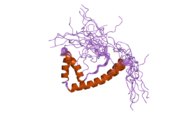TOX
| TOX | |||
|---|---|---|---|
Gene ontology | |||
| Molecular function | |||
| Cellular component | |||
| Biological process | |||
| Sources:Amigo / QuickGO | |||
Ensembl | |||||||||
|---|---|---|---|---|---|---|---|---|---|
| UniProt | |||||||||
| RefSeq (mRNA) | |||||||||
| RefSeq (protein) | |||||||||
| Location (UCSC) | Chr 8: 58.81 – 59.12 Mb | Chr 4: 6.69 – 6.99 Mb | |||||||
| PubMed search | [3] | [4] | |||||||
| View/Edit Human | View/Edit Mouse |

Thymocyte selection-associated high mobility group box protein TOX is a protein that in humans is encoded by the TOX gene.[5][6][7] TOX drives T-cell exhaustion[8][9] and plays a role in innate lymphoid cell development.[10][11]
Structure
The TOX gene encodes a
TOX subfamily
TOX is a member of a small subfamily of proteins (
Function
T cell exhaustion
TOX is necessary for T cell persistence but also drives
Effector function
Markers of effector functions that are decreased when TOX is overexpressed are KLRG1, TNF, and IFN-gamma.[8] IFN-gamma and TNF-alpha production are also increased when the Tox and Tox2 genes are deleted.[9] Upregulation of effector function in cells lacking TOX is not always seen and it has been proposed that inhibitory receptor function is separated from effector CD8+ cytotoxic T cell function.[8] T-cell exhaustion does not occur when TOX is deleted from CD8+ T cells, but the cells instead adopt the KLRG1+ terminal effector state and undergo apoptosis, or programmed cell death.[9] It was therefore proposed that TOX prevents this terminal differentiation and instead promotes exhaustion so that the T-cell has a slightly more sustained response.[9]
Cancer & chronic infection
In
Activation
NFAT transcription factors are essential for activating TOX in CD8+ T-cells,[8] and it has been suggested that TOX is a downstream target of NFAT.[9] The expression and function of NR4a (a target of NFAT) and TOX are strongly linked with reduced NR4a expression in Tox double knockout T cells and minimized Tox expression in NR4a triple knockout T cells.[9]
T-cell development
TOX is necessary for positive selection in developing thymocytes.[26] Knock out TOX mice shows a requirement of TOX for the CD4 T cell lineage,[26] however CD8 single positive T-cells were still able to develop.[26]
Innate lymphoid cells development
TOX is necessary for the development of innate lymphoid cells.[10][11] Innate lymphoid cells include ILC1, ILC2, ILC3 and NK cells.[26]
Notch signaling can aid in the development of all innate lymphoid cells, but in TOX-deficient cells, Notch target genes are expressed at low levels, so it is possible that TOX is required for downstream activation of these Notch target genes.[10] TOX was also found to bind Hes1, a Notch target gene, in embryonic kidney cells.[10]
Several
It has been proposed that NFIL3 and TOX regulate the transition of common lymphoid progenitor to early innate lymphoid progenitor.[11] In NFIL3-deficient mice, the expression of TOX is downregulated, indicating that NFIL3 is directly affecting the expression of TOX which is then acting downstream in ILC development.[11] TOX-deficient mice and NFIL3-deficient mice both lack mature ILCs and ILC progenitors.[11]
References
- ^ a b c GRCh38: Ensembl release 89: ENSG00000198846 – Ensembl, May 2017
- ^ a b c GRCm38: Ensembl release 89: ENSMUSG00000041272 – Ensembl, May 2017
- ^ "Human PubMed Reference:". National Center for Biotechnology Information, U.S. National Library of Medicine.
- ^ "Mouse PubMed Reference:". National Center for Biotechnology Information, U.S. National Library of Medicine.
- PMID 9872452.
- S2CID 19716719.
- ^ a b "Entrez Gene: thymocyte selection-associated high mobility group box gene TOX".
- ^ PMID 31243349.
- ^ PMID 31822213.
- ^ PMID 26556952.
- ^ PMID 32733432.
- ^ PMID 12697058.
- ^ S2CID 208145693.
- PMID 17529967.
- S2CID 7346190.
- PMID 18195075.
- S2CID 190528786.
- PMID 31207603.
- S2CID 190538130.
- ^ S2CID 195657349.
- PMID 31570879.
- ^ S2CID 226948315.
- PMID 32111241.
- PMID 32024970.
- S2CID 235808117.
- ^ PMID 22209117.
Further reading
- Nakajima D, Okazaki N, Yamakawa H, Kikuno R, Ohara O, Nagase T (June 2002). "Construction of expression-ready cDNA clones for KIAA genes: manual curation of 330 KIAA cDNA clones". DNA Research. 9 (3): 99–106. PMID 12168954.
- Sebastiani P, Wang L, Nolan VG, Melista E, Ma Q, Baldwin CT, Steinberg MH (March 2008). "Fetal hemoglobin in sickle cell anemia: Bayesian modeling of genetic associations". American Journal of Hematology. 83 (3): 189–195. S2CID 24667609.
- Aliahmad P, O'Flaherty E, Han P, Goularte OD, Wilkinson B, Satake M, et al. (April 2004). "TOX provides a link between calcineurin activation and CD8 lineage commitment". The Journal of Experimental Medicine. 199 (8): 1089–1099. PMID 15078895.

